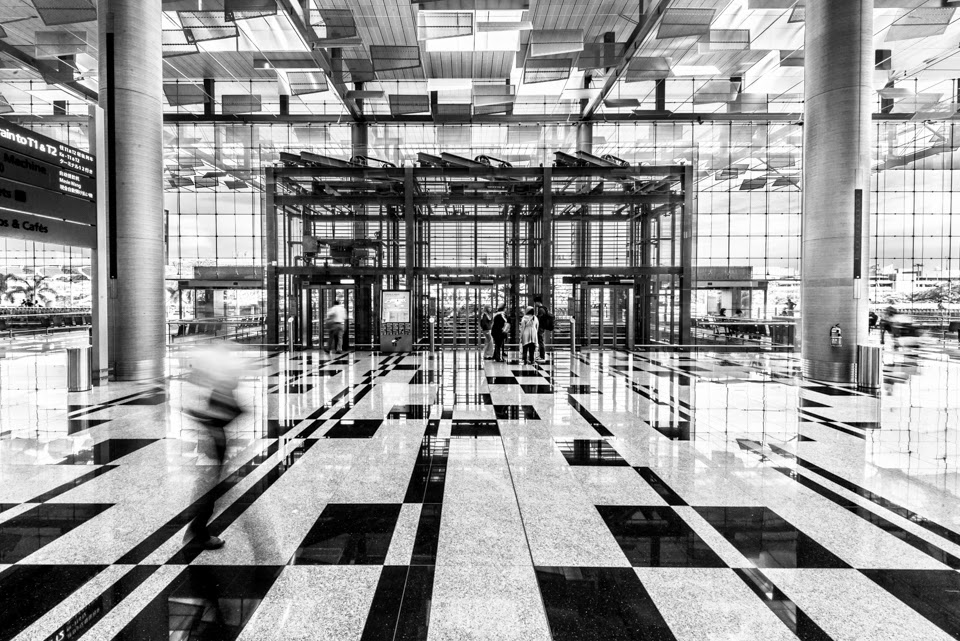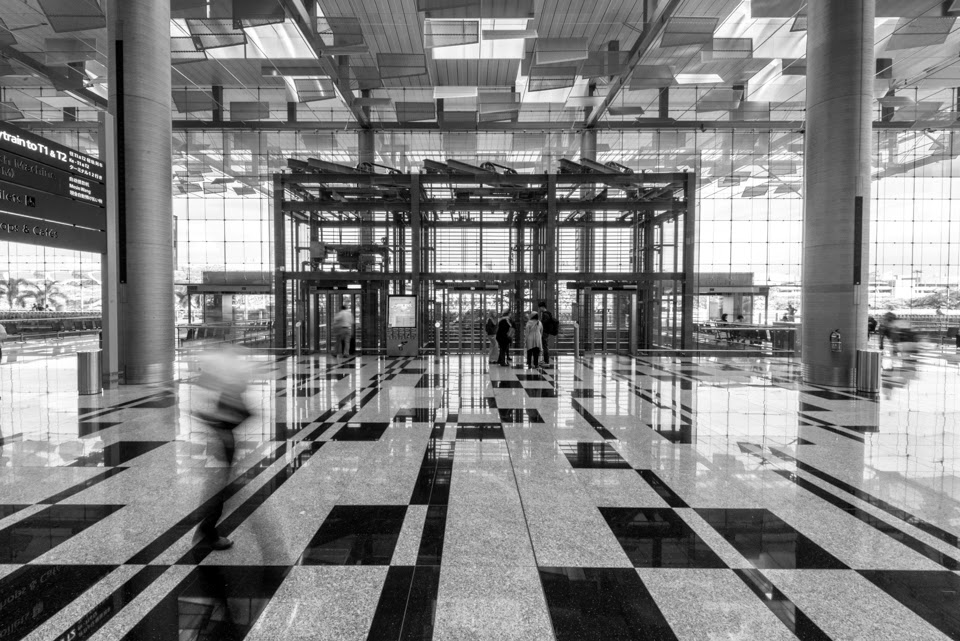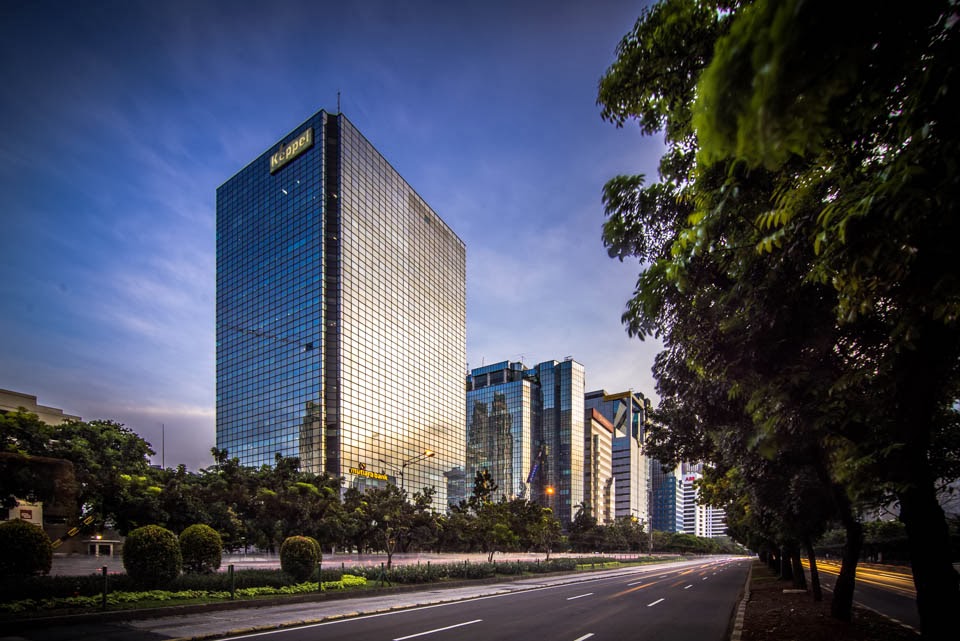Tuesday, December 2, 2014
Anatomy of a Shot
I was just in Singapore for a meeting, and as always, I bring my tripod and camera with me, because I find that there is always something interesting to photograph (grass is greener on the other side?)
Anyway, I was a little short on time, and didn't get to shoot anything, but when I got to the airport about to come back - I told myself that I HAD to shoot something, so that I didn't feel like I wasted the effort of lugging my camera stuff for nothing.
As usual, I'm drawn to the stark architecture of T3. 2 of the lift had the top covered by advertisements (urgh!), but managed to find one "naked", where I camped for 45min after checking in, and before having to board.
And just because it's been ages since I blogged, I thought I take a walk through the process of this shot, from beginning right up to the post processing.
First thing is to pick the scene, work on the composition of the frame. I wanted this lift to be the main focus of the shot, I liked the bare, industrial look of it, which fits in with the roofing, and the lines on the floor kinda lead to it. I took maybe 20-30 shots, trying out without filters, and with filters, various exposure times.
In the end, I selected this - coz I thought pictures without people looked too sterile and cold. The slow shutter speed gave a sense of movement - and the guy walking across, without blocking the lift was what I liked. A trick is that since I was camped there, all set up with a tripod and remote trigger, people will ignore you - if you pretend to look elsewhere. :)
Anyway, this is the RAW file.
Due to the nature of the lens (wide angle), you will see that the picture is "bent". But Lightroom has now evolved so that it auto-corrects the distortion. One click later and you get
Pretty neat huh! All the bent lines (and pillars) all straighten out.
Next, I strip out the colors, cause it adds nothing to it. I just love black and whites.
Now, the problem is, because the window scene is very bright, the rest of the picture (indoor) is a bit dark. The lift is lost in the business of the picture - so my global (affects the whole picture) adjustments in Lightroom is to lower the highlights, increase the shadows, and boost clarity.
I still didn't think that the lift stood out clearly enough, so I "darkened" the bright window more, darkened the lift, boosted overall exposure to accentuate the dark lift against the white background. I actually spent a bit of time fine-tuning this via the black and white sliders - to give the final image right on top.
The lessons are:
1. Start with an image you are happy with in terms of composition - this takes time and effort to experiment with various settings/filters.
2. Post processing is an important part of getting to how you envisage the final image to be. You will see that the final image is starkly different to the RAW. And whilst I don't really use photoshop, I am a big proponent of Lightroom - it is a important and very powerful tool - that is (almost) as important as the gear you use.
Happy Shooting!
Sunday, March 23, 2014
Anatomy of a Super Long Exposure Shot.
Holidays are the best times to explore and photograph new places.
Here's a shot of Rainbow Beach, just a stone's throw where we holidayed (in Gold Coast) just.
This is the EXIF: 16mm (as wide as you can go); ISO100 (native ISO, for the cleanest pictures); F16 (I always start with F16 in landscape shots); 446s (yes, that is more than 7 minutes).
Here's how its done.
Firstly, the key is composition. Take your time, look around, and find a composition that you like.
So I liked the dramatic clouds, foreground interests (big boulders). I decided not to go rule of thirds, and just shot the horizon at the middle, because I wasn't sure which I liked more - sky or boulders. In long exposures, the clouds are important, they are the paint brushes for the shot. But the foreground interest is the stability in the picture, that adds great contrasts. So I kept both.
Side note, shooting with the tripod in the sea - is difficult. I tried quite a few, but coz of waves, it ends up not tack sharp/blur. So I had to navigate through the boulders to find a spot for my tripod - stable enough, away from waves, and a decent composition.
Take your time.
So this is the first shot, without the ND filter. F16; 16mm; ISO100; 0.8s.
I love the ND filter, ever since I solved my light leakage problem, I was confident again in using this. A recap - this filter takes out 499/500 of the light hitting the camera sensor.
So if the shot above is 0.8s, with the filter, it should be 0.8 times 500 = 400 (or 6 min 40s). As the sun was setting, light was dropping - I let it go open for a bit more.
This is what I got.
I got this strange purple hue at the bottom right (the picture is already slightly corrected, but couldn't get rid of this) - so what I did was to convert it to Black and White - and you get the picture right on top.
So the ND filter smoothens out the water, giving you that milky tranquil feel. The clouds become your paint brush. It really is a trial and error process, you never really know what you are going to get. But if you don't try it, you won't know.
Also, with a 7 minute shot, you don't get many chances at this.
There you go. Keep shooting!
Monday, February 3, 2014
How a Hat solved my photography achilles heel
Since my trip to Australia in March last year, I've noticed that this line/purple hue appears whenever I use my Hoya ND400 filter (its a 9 stop filter which allows 1/500 of light through - to allow you to shoot long exposures) - see example above. Initially, it only appeared occasionally. Eventually, the filter fell apart, and I replaced it. I also upgraded my wide angle lens from Tokina 11-16 (DX lens) to Nikon 16-35 (Full Frame) lens. The frequency of the purple banding/line - became almost 100% - and asking my photography friends in Indonesia, in Singapore - no one had ever seen it. I didn't think it was the filter (since it was new, and also happened with the old filter), the lens or camera (since it doesn't appear when I don't use the filter).
This recent trip to Lombok, it appeared again! And I was determined to eliminate as many variables as possible, before I ditched the filter and adopt a new system.
So here's the normal 16mm shot, without filter.
The shot with the filter is right on top. Argh!
So, I tried it with a different lens - the 24-70mm. And this is the result:
ok, no problem right? Here's the same shot, with the ND filter.
Argh! So it definitely isn't a lens problem. Maybe a filter problem? I try the same shot, but this time, the filter is turned 90 degrees... to see if the line changes.
?!!! erm, three's no difference! I'm stumped. It isn't a problem with the filter, not the lens. I try searching on the internet again, and finally stumble on the problem - light leakage from the view finder! Its when you have light going through the view finder, leaking into the sensor. Its more pronounced during long exposures.
And so, since I didn't bring the view finder blocker (which I've never used) - I used my good old trust-worthy hat- and just hung it over the view-finder...
Voila! It works! Trying about 10 more different shots, the line is gone! Hurray!
Light leakage - it seems to be more camera specific, and happens with the D600 (didn't happen with my D90). So if it happens, use your hat!
Thursday, January 23, 2014
Exploring Lightroom 5's Perspective Correction
An interesting picture of one of Jakarta's main streets - Jl. Jend. Sudirman at right at peak hour. So I used a 10 stop Neutral Density filter, so the busy cars zipped by (slowly), leaving only bare trace of light trails.
And as I used a 16mm lens, you'll see the lens distortion - buildings aren't upright. And you'll need photoshop to correct it.
However, since the release of Lightroom 5, a new feature is the perspective correction - which I tried. So the "Auto" turns out like this:
Not too bad - the buildings are more or less upright, but maybe a little to much as the top looks bigger than the bottom.
There is a "Full" perspective correction, which makes the picture like this:
So.... not always turns out well.
Summary: It's a useful little feature, which is a one click adjustment. Works out some of the time - whether "Full" or "Auto", try and experiment to see which turns out better, or which you like better.
Is it worth an upgrade to LR5, if you have say LR 4? Prob not. But if you have it, use it.
Keep Shooting!
Soo Sing
Subscribe to:
Posts (Atom)
















